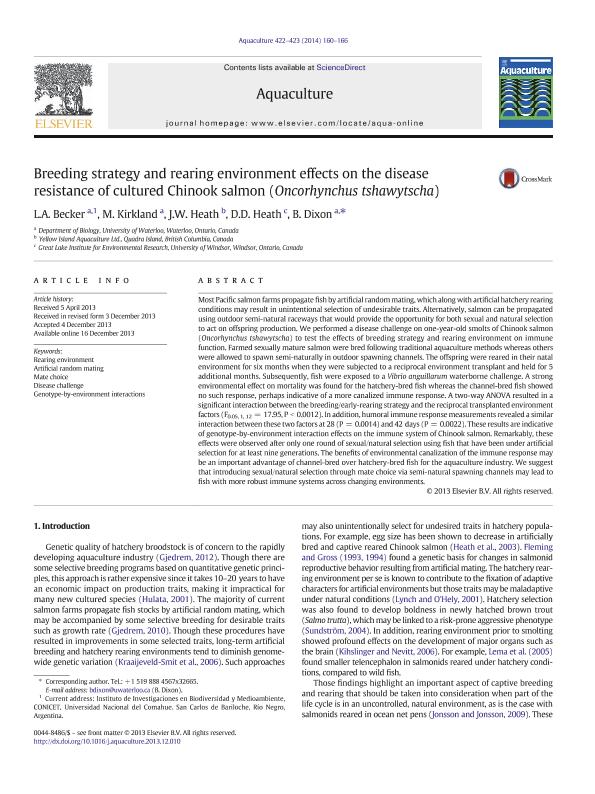Mostrar el registro sencillo del ítem
dc.contributor.author
Becker, Leandro Anibal

dc.contributor.author
Kirkland, M.
dc.contributor.author
Heath, J. W.
dc.contributor.author
Heath, D. D.
dc.contributor.author
Dixon, B.
dc.date.available
2016-07-22T19:49:10Z
dc.date.issued
2014-02
dc.identifier.citation
Becker, Leandro Anibal; Kirkland, M.; Heath, J. W.; Heath, D. D.; Dixon, B.; Breeding strategy and rearing environment effects on the disease resistance of cultured Chinook salmon (Oncorhynchus tshawytscha); Elsevier; Aquaculture; 422-423; 2-2014; 160-166
dc.identifier.issn
0044-8486
dc.identifier.uri
http://hdl.handle.net/11336/6648
dc.description.abstract
Most Pacific salmon farms propagate fish by artificial random mating, which along with artificial hatchery rearing conditions may result in unintentional selection of undesirable traits. Alternatively, salmon can be propagated using outdoor semi-natural raceways that would provide the opportunity for both sexual and natural selection to act on offspring production. We performed a disease challenge on one-year-old smolts of Chinook salmon (Oncorhynchus tshawytscha) to test the effects of breeding strategy and rearing environment on immune function. Farmed sexually mature salmon were bred following traditional aquaculture methods whereas others were allowed to spawn semi-naturally in outdoor spawning channels. The offspring were reared in their natal environment for six months when they were subjected to a reciprocal environment transplant and held for 5 additional months. Subsequently, fish were exposed to a Vibrio anguillarum waterborne challenge. A strong environmental effect on mortality was found for the hatchery-bred fish whereas the channel-bred fish showed no such response, perhaps indicative of a more canalized immune response. A two-way ANOVA resulted in a significant interaction between the breeding/early-rearing strategy and the reciprocal transplanted environment factors (F0.05, 1, 12 = 17.95, P b 0.0012). In addition, humoral immune response measurements revealed a similar interaction between these two factors at 28 (P = 0.0014) and 42 days (P = 0.0022). These results are indicative of genotype-by-environment interaction effects on the immune system of Chinook salmon. Remarkably, these effects were observed after only one round of sexual/natural selection using fish that have been under artificial selection for at least nine generations. The benefits of environmental canalization of the immune response may be an important advantage of channel-bred over hatchery-bred fish for the aquaculture industry. We suggest that introducing sexual/natural selection through mate choice via semi-natural spawning channels may lead to fish with more robust immune systems across changing environments.
dc.format
application/pdf
dc.language.iso
eng
dc.publisher
Elsevier

dc.rights
info:eu-repo/semantics/openAccess
dc.rights.uri
https://creativecommons.org/licenses/by-nc-nd/2.5/ar/
dc.subject
Rearing Environment
dc.subject
Artificial Random Mating
dc.subject
Mate Choice
dc.subject
Disease Challenge
dc.subject
Genotype-By-Environment Interactions
dc.subject.classification
Biología Marina, Limnología

dc.subject.classification
Ciencias Biológicas

dc.subject.classification
CIENCIAS NATURALES Y EXACTAS

dc.title
Breeding strategy and rearing environment effects on the disease resistance of cultured Chinook salmon (Oncorhynchus tshawytscha)
dc.type
info:eu-repo/semantics/article
dc.type
info:ar-repo/semantics/artículo
dc.type
info:eu-repo/semantics/publishedVersion
dc.date.updated
2016-07-22T18:53:43Z
dc.journal.volume
422-423
dc.journal.pagination
160-166
dc.journal.pais
Países Bajos

dc.journal.ciudad
Amsterdam
dc.description.fil
Fil: Becker, Leandro Anibal. Consejo Nacional de Investigaciones Científicas y Técnicas. Centro Científico Tecnológico Patagonia Norte. Instituto de Investigación En Biodiversidad y Medioambiente; Argentina. University Of Waterloo; Canadá
dc.description.fil
Fil: Kirkland, M.. University Of Waterloo; Canadá
dc.description.fil
Fil: Heath, J. W.. Yellow Island Aquaculture Ltd.; Canadá
dc.description.fil
Fil: Heath, D. D.. University Of Windsor. Great Lakes Institute For Enviromental Research; Canadá
dc.description.fil
Fil: Dixon, B.. University Of Waterloo; Canadá
dc.journal.title
Aquaculture

dc.relation.alternativeid
info:eu-repo/semantics/altIdentifier/url/http://www.sciencedirect.com/science/article/pii/S0044848613006492
dc.relation.alternativeid
info:eu-repo/semantics/altIdentifier/doi/http://dx.doi.org/10.1016/j.aquaculture.2013.12.010
dc.relation.alternativeid
info:eu-repo/semantics/altIdentifier/doi/10.1016/j.aquaculture.2013.12.010
Archivos asociados
